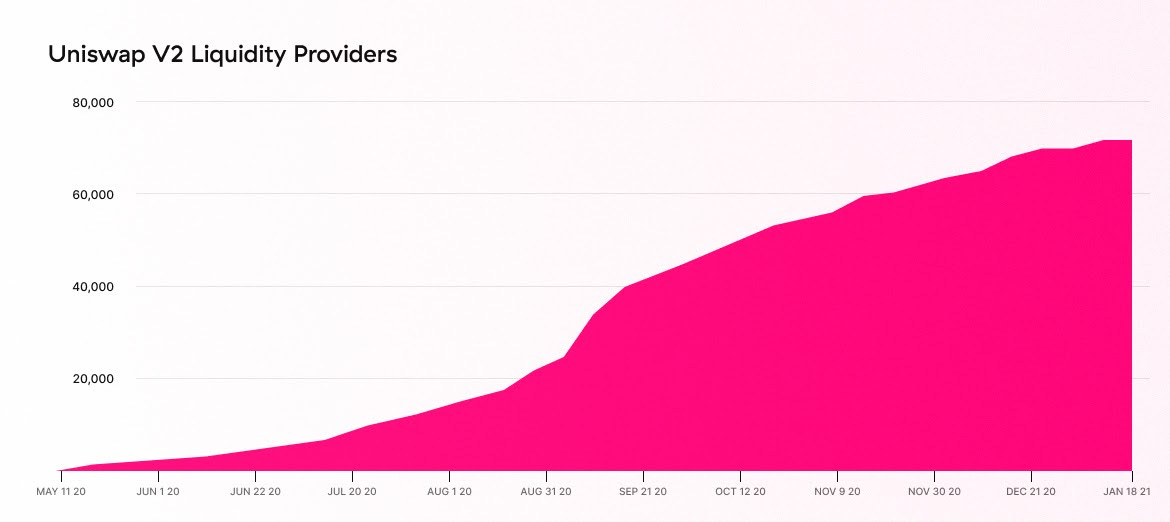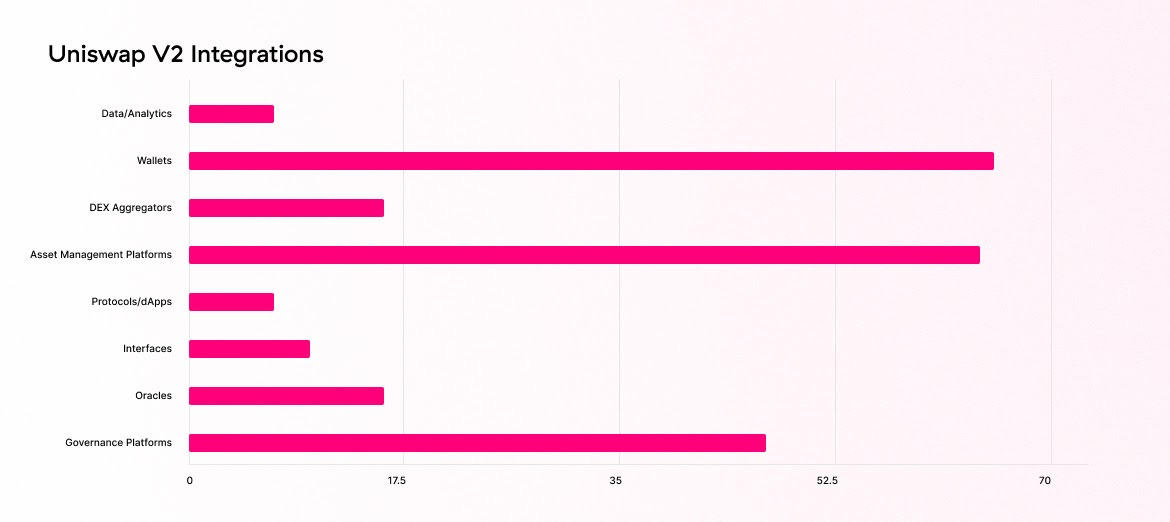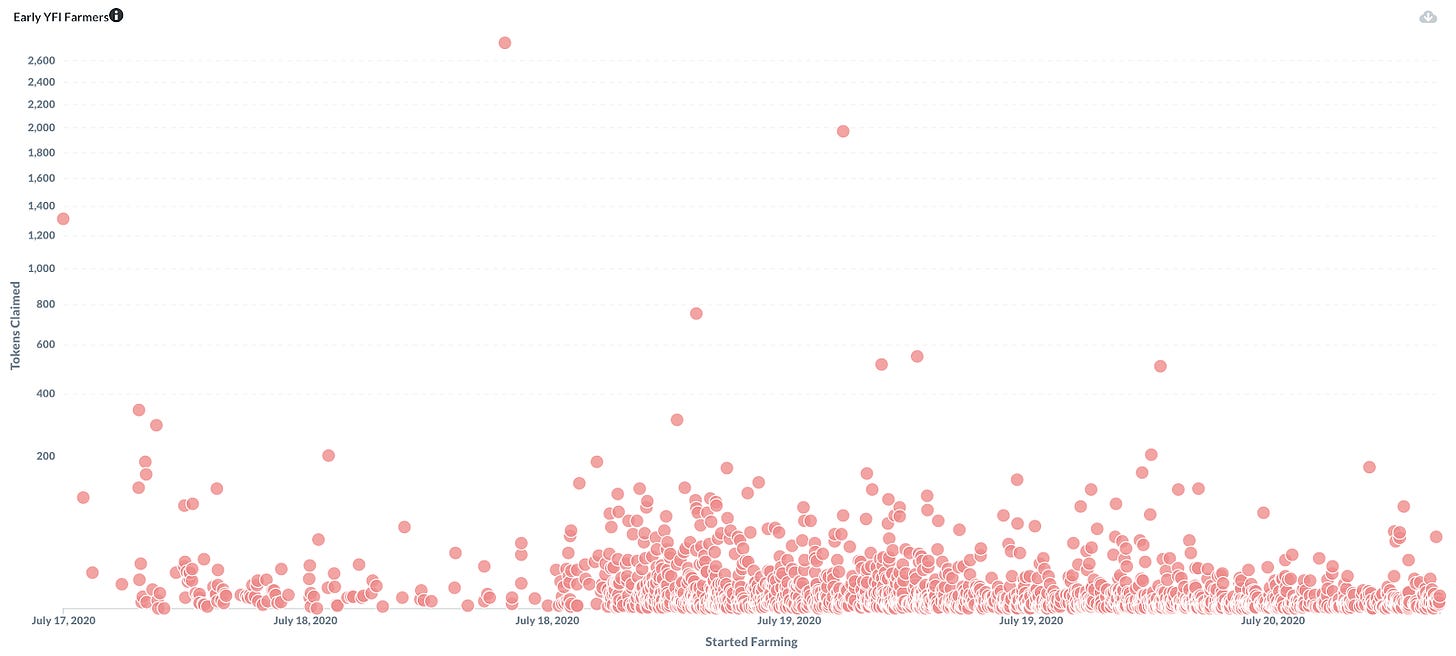Continued from Part 1.
③ Uniswap (cont.)
Liquidity Provider growth shows no sign of abating, even in the absence of liquidity mining subsidies: over 70,000 unique addresses now provide $3.5bn liquidity across 28,500 unique pairs (a new pair has been created every 12 minutes since the launch of the v2 protocol in May 2020). The past four weeks have all seen net positive liquidity inflows with market participants continuing to seek exposure to double-digit annualized yields: as of January 21, ETH/stablecoin pairs are generating 50%+ annualized gross returns.
Uniswap governance now supports an official grants program, led by Ken Ng from the Ethereum Foundation and assisted by a handful of decentralized finance industry leaders. Over 5,000 unique addresses have registered as governance delegates, with notable recent additions including the Berkeley, UCLA, Stanford, and Harvard-associated student blockchain groups. The Uniswap community currently has access to ~55m UNI (~$410m today) out of the 430m UNI (~$3.2b today) that will ultimately vest to the governance treasury: these UNI can be allocated through on-chain governance proposals.
Uniswap counts over 200 integrations across protocols, data analytics services, advanced interfaces, wallets, and more. Uniswap’s Time Weighted Average Price (TWAP) oracle now supports over 66 protocol integrations alone — second only to Chainlink — with highlights including Compound, Augur v2, and Empty Set Dollar. Meanwhile, Uniswap LP shares are gaining traction as a collateral type, with ETH/DAI shares backing over 1.5m DAI outstanding debt via on-chain credit facility, MakerDAO.
④ Yearn Finance
Contributors: dudesahn and Facu Ameal, Core Contributors at Yearn Finance
YFI’s “fair launch” eventually became somewhat of a meme with countless clones, forks, and new projects adopting the staking-based distribution method. However, as we can see below in the graph courtesy of Nansen’s YFI dashboard, it was actually fairly effective at evenly distributing the token. Despite the fact that liquidity mining was extremely popular due to Compound’s token release a month prior, only nine early farmers were able to secure greater than 1% of the YFI supply.
Following YFI’s distribution, Yearn’s governance with YFI staking formally launched. Below, in a graph modified from the Dune Analytics dashboard created by 0xBoxer, we can see that over half of all YFI was quickly staked in governance. However, in early August C.R.E.A.M. launched, with high CREAM rewards for YFI, causing a flow from gov staking to the new Compound fork. A few days later, YAM launched, and at one point nearly half of all YFI was staked in their famously unaudited contracts.
After YAM’s distribution finished, YFI flowed back to governance staking and into the YFI vault (which was deposited into C.R.E.A.M.). In late August, Aave added YFI as collateral, causing a resurgence of YFI deposits in money markets, decreasing holdings in governance staking. As September (and DeFi Summer) came to a close, YFI started to flow more to centralized exchanges, and like with many DeFi tokens corresponded with what turned out to be a short-lived “DeFi Bear Market”.
Looking at the current token distribution today, we can see that while the top two holders are Binance and Coinbase, there are still considerable amounts of YFI in DeFi protocols such as SushiSwap, Aave, and Yearn’s own governance staking. In total, more than 21,000 addresses hold YFI, a number that has more than doubled over the past three months. Overall, a little over 1/3 of all YFI is held in CEXs like Coinbase, Binance, and FTX.
Focusing specifically on DeFi protocols, we can see that most YFI whales choose to deploy their funds to either Aave or SushiSwap. Interestingly, only four different holders utilizing DeFi protocols (excluding Binance’s governance staking) hold more than 1% of all YFI in their wallet. In total, approximately 3,200 addresses hold at least 0.01 YFI in DeFi protocols, for a grand total of just over 10,000 YFI. Combined with the 10,000 on CEXs, this leaves an additional ~10,000 YFI stored in external wallets (many of them likely cold wallets).








